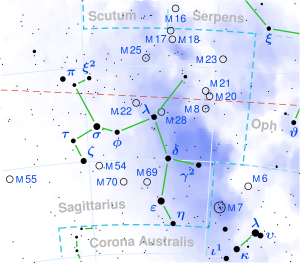| Observation data Epoch J2000 Equinox J2000 | |
|---|---|
| Constellation | Sagittarius |
| Right ascension | 18h 02m 51.09872s[1] |
| Declination | −24° 16′ 56.8825″[1] |
| Apparent magnitude (V) | 5.37[2] |
| Characteristics | |
| Spectral type | F2 II/III[3] |
| U−B color index | 0.25[4] |
| B−V color index | 0.51[4] |
| Astrometry | |
| Radial velocity (Rv) | −11.2±1.0[5] km/s |
| Proper motion (μ) | RA: +1.22[1] mas/yr Dec.: −17.52[1] mas/yr |
| Parallax (π) | 3.02 ± 0.28 mas[1] |
| Distance | 1,100 ± 100 ly (330 ± 30 pc) |
| Absolute magnitude (MV) | −2.21[2] |
| Details | |
| Radius | 18[6] R☉ |
| Luminosity | 658.07[2] L☉ |
| Surface gravity (log g) | 3.54±0.20[5] cgs |
| Temperature | 6,800±200[5] K |
| Metallicity [Fe/H] | 0.0[5] dex |
| Rotational velocity (v sin i) | 35[7] km/s |
| Other designations | |
| Database references | |
| SIMBAD | data |

7 Sagittarii is a massive star in the southern zodiac constellation of Sagittarius which is located in the Lagoon Nebula (NGC 6530),[9] although multiple sources have considered it a foreground star.[10] It is a dim star but visible to the naked eye with an apparent visual magnitude of 5.37.[2] The distance to this star can be determined from the annual parallax shift of 3.02±0.28 mas,[1] yielding a value of roughly 1,100 light years. It is moving closer to the Sun with a heliocentric radial velocity of −11 km/s.[5]
Gray and Garrison (1989) listed a stellar classification of F2 II/III[3] for this star, suggesting it is a K-type star with a spectrum showing mixed traits of a giant/bright giant. Houk and Smith-Moore (1978) had a similar classification of F2/3 II/III.[11] This may indicate it is not a member of NGC 6530, since it should not have evolved to this class from the O-type stars that still populate this cluster, and hasn't had time to evolve from a less massive cluster star.[10]
It is a suspected chemically peculiar star.[4][5] The spectral class from the calcium K line has been given as A8 while the class determined from other metallic lines was F4, making it an Am star.[12] This peculiarity is now considered doubtful.[4]
7 Sagittarii has an estimated 18[6] times the Sun's radius and is radiating 658[2] times the Sun's luminosity from its photosphere at an effective temperature of around 6,800 K.[5]
- ^ a b c d e f Cite error: The named reference
vanLeeuwen2007was invoked but never defined (see the help page). - ^ a b c d e Cite error: The named reference
Anderson2012was invoked but never defined (see the help page). - ^ a b Cite error: The named reference
Gray1989was invoked but never defined (see the help page). - ^ a b c d Cite error: The named reference
aaa498_3_961was invoked but never defined (see the help page). - ^ a b c d e f g Cite error: The named reference
Khalack2015was invoked but never defined (see the help page). - ^ a b Cite error: The named reference
Fracassini2001was invoked but never defined (see the help page). - ^ Cite error: The named reference
Rutten1988was invoked but never defined (see the help page). - ^ Cite error: The named reference
SIMBADwas invoked but never defined (see the help page). - ^ Cite error: The named reference
Damiani2017was invoked but never defined (see the help page). - ^ a b Cite error: The named reference
Sowell1987was invoked but never defined (see the help page). - ^ Cite error: The named reference
houk1978was invoked but never defined (see the help page). - ^ Cite error: The named reference
Hauck1973was invoked but never defined (see the help page).
